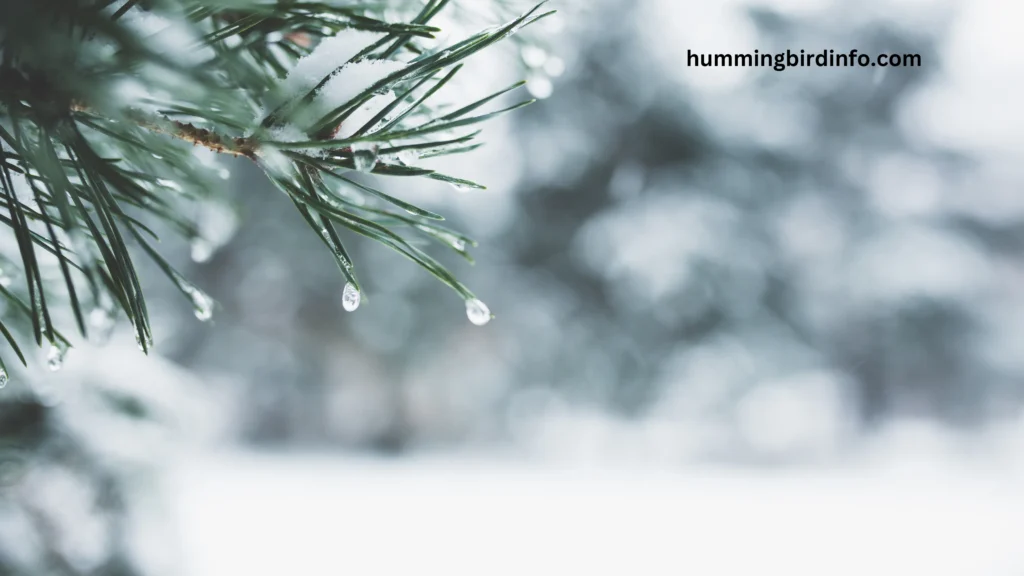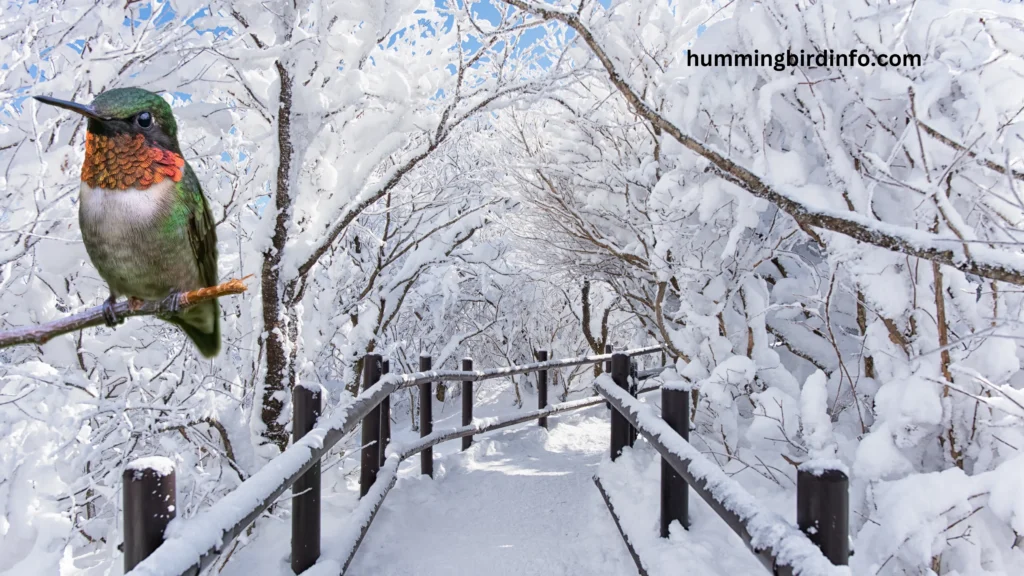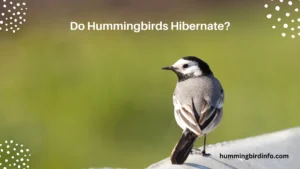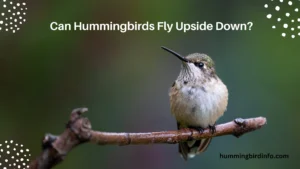The Challenge of Winter:
Winter is a challenging season for many creatures, but for hummingbirds, it is particularly tough. These tiny, energetic birds rely heavily on a consistent food supply, which becomes scarce as the temperature drops and flowers wither away.
They also face cold temperatures that make survival difficult without a proper strategy. Shorter days mean less time for foraging, and harsh weather conditions can make it even harder to find food sources.
Diverse Strategies for Survival:
Hummingbirds have developed fascinating and diverse strategies to cope with winter’s challenges. Some species rely on migration, flying thousands of miles to warmer climates.
Others enter torpor, a unique state of deep sleep that allows them to conserve energy. Some may even adjust their diet, switching from nectar to insects when flowers are no longer abundant.
The combination of these tactics ensures their survival, but not all species use the same methods. Their responses to winter are as varied as their colorful plumage.
Human Influence on Survival:
While migration and torpor help hummingbirds survive the cold, human activities have also played a role in their ability to endure winter. The use of feeders, the planting of native winter-blooming plants, and the creation of shelters all contribute to helping these birds make it through the harsh months.
However, human impact can be a double-edged sword. For instance, the use of pesticides can harm their food sources, and climate change is altering the conditions that hummingbirds rely on for survival.
In this article, we will dive deeper into the incredible strategies hummingbirds use to survive the winter. From migration routes to the science of torpor, dietary shifts, and the role of human assistance, we will explore how these remarkable creatures navigate the coldest months of the year.
Contents
- 1 Migration: Heading South for the Winter
- 2 Conclusion:
- 3 FAQs
- 4 Do all hummingbirds migrate?
- 5 How long do hummingbirds stay in torpor?
- 6 Can hummingbirds survive in freezing temperatures?
- 7 Why do hummingbirds eat insects?
- 8 How do hummingbirds find shelter during winter?
- 9 How do feeders help hummingbirds survive winter?
Migration: Heading South for the Winter
Why Migration?
For most hummingbird species, migration is the primary strategy for dealing with winter. As cold-blooded animals, hummingbirds cannot survive in freezing temperatures, and their high metabolic rate demands a constant source of food.
Migration is triggered by a combination of decreasing day length, lower temperatures, and scarcity of nectar. When these signals prompt their migratory instincts, hummingbirds embark on long journeys to warmer climates.
Migration Routes:
Hummingbirds typically migrate from North America to Central America and Mexico, but the routes vary by species. For example, the Ruby-throated Hummingbird is well-known for crossing the Gulf of Mexico during migration, a feat that requires tremendous endurance and energy.
Similarly, the Rufous Hummingbird makes the long journey from Alaska to Mexico, and others like the Broad-tailed and Calliope Hummingbirds also make similar long-distance migrations.
Challenges of Migration:
While migration offers a solution to winter survival, it comes with its own set of challenges. Exhaustion, predation, and extreme weather all pose significant risks along the way.
Hummingbirds may face storms or cold fronts that disrupt their journey, making it even harder to reach their destination safely. Some may even run out of food along the way, which increases their vulnerability.
Physiological Adaptations for Migration:
Hummingbirds undergo significant physiological preparation for migration. They build fat reserves to provide the energy needed for long-distance flights. This fat is stored in the breast muscles and is used to fuel their continuous, rapid wingbeats.
Their ability to metabolize fat at an extraordinary rate enables them to fly for hours without stopping. Their high metabolism allows them to fly across vast distances without slowing down.

Torpor: A State of Deep Sleep
What is Torpor?
Unlike hibernation, which is a long-term state of dormancy, torpor is a temporary, daily adaptation that allows hummingbirds to conserve energy. During torpor, a hummingbird’s metabolic rate drops significantly, slowing its heart rate and lowering its body temperature.
This extreme reduction in metabolic processes can help the bird survive harsh conditions when food is scarce.
How Does Torpor Work?
When in torpor, a hummingbird’s body temperature can drop from the usual 100°F to as low as 40°F. The heart rate slows from hundreds of beats per minute to just a few dozen. In addition, the breathing rate and oxygen consumption decrease significantly, allowing the bird to conserve precious energy.
Torpor is crucial for surviving cold nights or periods of food scarcity, as it reduces the bird’s energy expenditure.
Daily Torpor:
For many species, torpor is used daily, especially at night when it’s cold, and there is little food available. Torpor is triggered by the ambient temperature, lack of food, or the time of day.
When the temperatures drop at night, hummingbirds may enter this deep sleep, reducing their energy consumption to survive until morning.
Arousal from Torpor:
Waking from torpor requires a significant amount of energy. The hummingbird must “shiver” to generate heat and gradually raise its body temperature to normal levels. This process can take a few hours, and during this time, the bird is highly vulnerable to predation.
Ecological Significance of Torpor:
Torpor is vital for winter survival as it allows hummingbirds to endure periods of food scarcity and survive colder conditions. It is an energy-efficient way for these birds to survive when they are unable to find food, such as during harsh winters or prolonged cold spells.
Dietary Adaptations: Beyond Nectar
Nectar and Insects:
While nectar is the primary food source for hummingbirds, providing them with the sugar they need for energy, it’s not always available during winter. In the colder months, hummingbirds often turn to insects for nutrition.
Insects provide essential protein and other nutrients that nectar lacks, making them a crucial part of a winter diet.
Insectivory:
Hummingbirds are not strict nectarivores; they also consume insects, such as flies, spiders, and larvae. These insects are rich in protein, fats, and other nutrients that help the birds maintain their energy and overall health.
This dietary shift is particularly important when nectar is scarce, such as in late fall and winter.
Increased Insect Consumption in Winter:
During the winter, when flowers are fewer, hummingbirds increase their insect consumption. Their long, slender beaks are not just designed for nectar; they can also catch insects mid-flight or glean them from surfaces.
They may feed on insects in tree bark, cobwebs, or other protected places, especially in sheltered areas where insects are more abundant.

Behavioral Adaptations: Seeking Shelter and Staying Warm
Seeking Shelter:
Hummingbirds need to seek shelter to protect themselves from cold weather, rain, snow, and wind. Sheltered locations like dense foliage, tree cavities, or even under eaves of human structures provide protection from the elements.
This shelter provides a microclimate with slightly warmer temperatures and reduces exposure to harsh winds.
Roosting Behavior:
At night, hummingbirds typically roost in places where they can minimize heat loss. They perch in a way that limits exposure to cold air, and they may even huddle together to conserve heat. The roosting behavior allows them to rest and preserve their energy overnight.
Social Behavior:
Though hummingbirds are generally solitary, some species may gather in small groups during winter, especially in areas where food and shelter are abundant. This social behavior may help them stay warm and protect each other from predators.
Conclusion:
As winter approaches, hummingbirds face numerous challenges. Their survival is a result of an amazing array of adaptations, from migration to torpor, dietary shifts, and behavioral strategies. By understanding these survival tactics, we can appreciate just how resilient these tiny creatures are.
However, the challenges they face are compounded by climate change, habitat loss, and human-induced threats.
It’s essential that we support their survival by providing feeders, shelters, and protecting their natural habitats. Every action counts in helping these incredible birds thrive through the cold months.
FAQs
Do all hummingbirds migrate?
Not all species migrate. While many species, like the Ruby-throated Hummingbird, migrate, some species, like Anna’s Hummingbirds, stay in warmer regions throughout the winter.
How long do hummingbirds stay in torpor?
Hummingbirds can remain in torpor for several hours, usually overnight, to conserve energy during colder temperatures.
Can hummingbirds survive in freezing temperatures?
Hummingbirds cannot survive freezing temperatures for long, but they can survive them if they enter torpor or migrate to warmer areas.
Why do hummingbirds eat insects?
Insects provide essential protein and nutrients that nectar lacks, especially when nectar is scarce in winter.
How do hummingbirds find shelter during winter?
They seek shelter in dense foliage, tree cavities, or human structures that provide protection from the cold.
How do feeders help hummingbirds survive winter?
Feeders provide a consistent food source, especially sugar water, when natural nectar is scarce.








